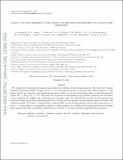Galaxy and Mass Assembly (GAMA) : Impact of the Group Environment on Galaxy Star Formation
Abstract
We explore how the group environment may affect the evolution of star-forming galaxies. We select 1197 Galaxy And Mass Assembly groups at 0.05 ≤ z ≤ 0.2 and analyze the projected phase space (PPS) diagram, i.e., the galaxy velocity as a function of projected group-centric radius, as a local environmental metric in the low-mass halo regime 1012 ≤ (M 200/M ⊙) < 1014. We study the properties of star-forming group galaxies, exploring the correlation of star formation rate (SFR) with radial distance and stellar mass. We find that the fraction of star-forming group members is higher in the PPS regions dominated by recently accreted galaxies, whereas passive galaxies dominate the virialized regions. We observe a small decline in specific SFR of star-forming galaxies toward the group center by a factor ~1.2 with respect to field galaxies. Similar to cluster studies, we conclude for low-mass halos that star-forming group galaxies represent an infalling population from the field to the halo and show suppressed star formation.
Citation
Barsanti , S , Owers , M S , Brough , S , Davies , L J M , Driver , S P , Gunawardhana , M L P , Holwerda , B W , Liske , J , Loveday , J , Pimbblet , K A , Robotham , A S G & Taylor , E N 2018 , ' Galaxy and Mass Assembly (GAMA) : Impact of the Group Environment on Galaxy Star Formation ' , Astrophysical Journal , vol. 857 , no. 1 , 71 . https://doi.org/10.3847/1538-4357/aab61a
Publication
Astrophysical Journal
Status
Peer reviewed
ISSN
0004-637XType
Journal article
Description
MSO acknowledges the funding support from the Australian Research Council through a Future Fellowship (FT140100255). SB acknowledges funding support from the Australian Research Council through a Future Fellowship (FT140101166).Collections
Items in the St Andrews Research Repository are protected by copyright, with all rights reserved, unless otherwise indicated.
Related items
Showing items related by title, author, creator and subject.
-
SDSS-IV MaNGA: How the stellar populations of passive central galaxies depend on stellar and halo mass
Oyarzún, Grecco A.; Bundy, Kevin; Westfall, Kyle B.; Tinker, Jeremy L.; Belfiore, Francesco; Argudo-Fernández, Maria; Zheng, Zheng; Conroy, Charlie; Masters, Karen L.; Wake, David; Law, David R.; McDermid, Richard M.; Aragón-Salamanca, Alfonso; Parikh, Taniya; Yan, Renbin; Bershady, Matthew; Sánchez, Sebastián F.; Andrews, Brett H.; Fernández-Trincado, José G.; Lane, Richard R.; Bizyaev, D.; Boardman, Nicholas Fraser; Lacerna, Ivan; Brownstein, J. R.; Drory, Niv; Zhang, Kai (2022-07-06) - Journal articleWe analyze spatially resolved and co-added SDSS-IV MaNGA spectra with signal-to-noise ratio ∼100 from 2200 passive central galaxies (z ∼ 0.05) to understand how central galaxy assembly depends on stellar mass (M*) and halo ... -
Secular-and merger-built bulges in barred galaxies
Mendez Abreu, Jairo; Debattista, V. P.; Corsini, E. M.; Aguerri, J. A. L. (2014-12) - Journal articleContext. Historically, galaxy bulges were thought to be single-component objects at the center of galaxies. However, this picture is now questioned since different bulge types with different formation paths, namely classical ... -
Galaxy And Mass Assembly (GAMA) : galaxy close pairs, mergers and the future fate of stellar mass
Robotham, A. S. G.; Driver, S. P.; Davies, L. J. M.; Hopkins, A. M.; Baldry, I. K.; Agius, N. K.; Bauer, A. E.; Bland-Hawthorn, J.; Brough, S.; Brown, M. J. I.; Cluver, M.; De Propris, R.; Drinkwater, M. J.; Holwerda, B. W.; Kelvin, L. S.; Lara-Lopez, M. A.; Liske, J.; Lopez-Sanchez, A. R.; Loveday, J.; Mahajan, S.; McNaught-Roberts, T.; Moffett, A.; Norberg, P.; Obreschkow, D.; Owers, M. S.; Penny, S. J.; Pimbblet, K.; Prescott, M.; Taylor, E. N.; van Kampen, E.; Wilkins, S. M. (2014-11-11) - Journal articleWe use a highly complete subset of the Galaxy And Mass Assembly II (GAMA-II) redshift sample to fully describe the stellar mass dependence of close pairs and mergers between 10(8) and 10(12)M(circle dot). Using the analytic ...

